Why do green tea masters steam tea? Why do tea farmers let the leaves sit out for a period of time before they roll it up? Why did humankind decide that this particular order of letting it be steamed, then be rolled and dried was the most advantageous for a tasty green tea? After visiting several tea farms, it made little sense to me why this practice of making tea is the standard, and why these particular steps are the way, other than conservation of tradition. Picking the brains of the people who grew the tea, asking questions like “why would you uproot old tea trees for new ones” and the difficulties of switching cultivars, gave me some bits of tea farmer knowledge, but didn’t alleviate my confusion and itching realization that I was probably missing a mental model of why tea is tea.
There’s plenty of tea content online that tells you how to brew tea and the health consequences of drinking it, but not necessarily comprehensive scientific detail on what tea is. I found amazing tea content from Wu Mountain Tea, and Dylan is such a great teacher on how to think about tea scientifically. Most of the information in my slides and in this blog post is organized around his thinking, with some references that I found. Please check out his video if you have the time, it’s long but super comprehensive. I’ve written this article online as my take on how to explain an introduction to tea science, but of course, feel free to take your tea exploration further.
What is tea?
Many drinks are called tea, but only a subset can be scientifically called a tea. Tea must be made from the plant Camelia Sinesis. Therefore, other teas like barley and hibiscus are technically called tisanes. The craziest thing about tea, is that all of the tea types: green, white, yellow, oolong, black and dark tea, are made from the same leaf. This means a tea leaf picked in Japan (that’s traditionally made into green tea), can actually be made into black tea.
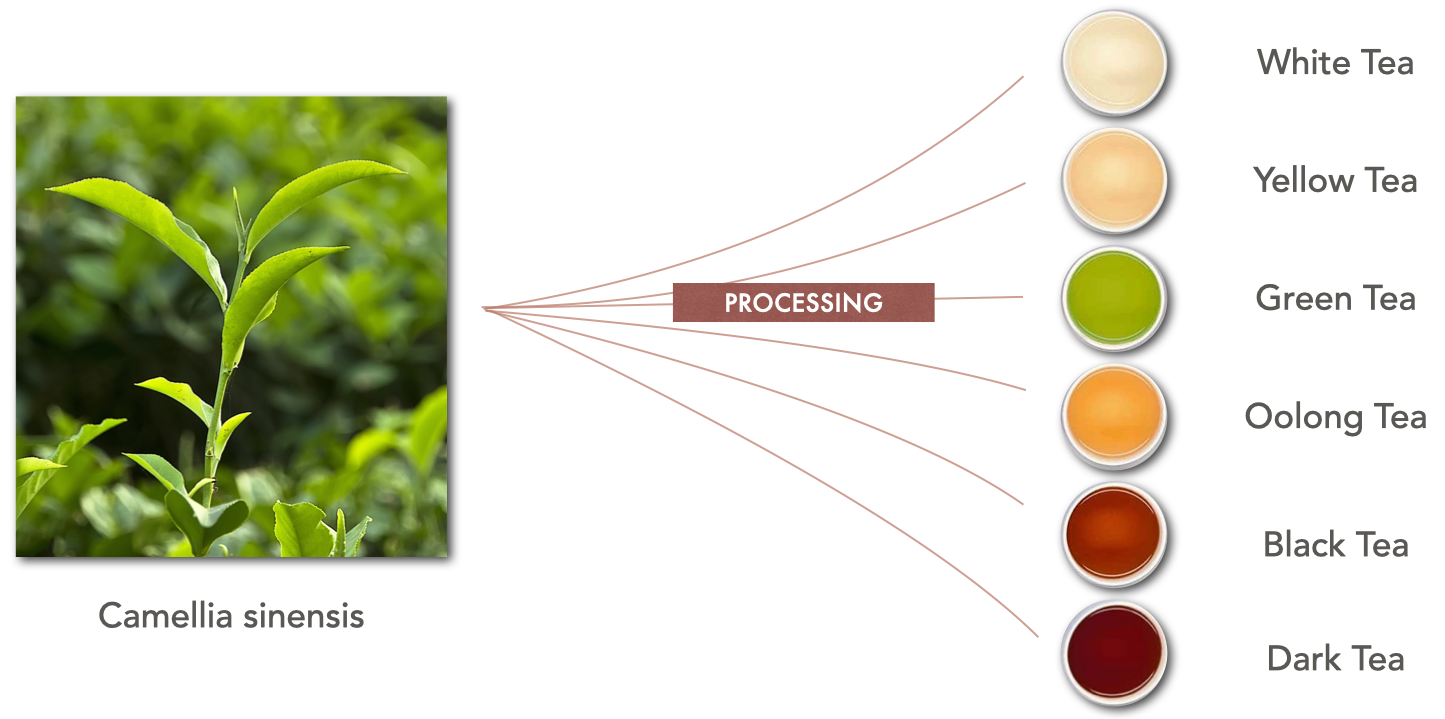
Any tea leaf can be made into any tea type
Tea can be classified by several factors including the type, processing, shape, location, cultivar, and flush to name a few. Processing typically refers to the any type of batch specific tea processing steps that may vary, like oxidation level. Shape is how the tea is rolled, and it determines how quickly the tea leaf will unfurl in the water, which is correlated with quality because you want tea to last a couple of steeps. The shape style is also characteristic of certain styles of tea; for example, Japanese sencha is only rolled in the needle style.
This is lesser known, but cultivar refers to the specific strain or breed of the tea plant, and they have different tasting characteristics. The taste characteristics are similar to how we would compare grape types in wine, likened to how Cabernet Sauvignon tastes different from a Syrah even though they are both heavy tannin red wines. And equally, location is just as important to tea as wine, because the terroir can equally affect the way the tea grows. A black tea in China of the same cultivar does not taste the same as a black tea in Taiwan. Last of all, one that I think is unique to tea is the flush. Tea can be picked multiple times a year usually 3 and up to 5. The season in which it is picked drastically changes the sweet and umami profiles of the tea.
Tea Processing
Tea processing is the process from a fresh leaf to a dried tea leaf, and you’ll learn there are a few key steps to controlling the oxidation level of the tea, which determines the tea type. However, we’ll first start with tea composition, which will tell us what the fresh leaf is composed of, and see how oxidation changes the tea composition.
Tea Composition
Tea is composed of 3 main compounds: L-theanine, catechins, and caffeine.
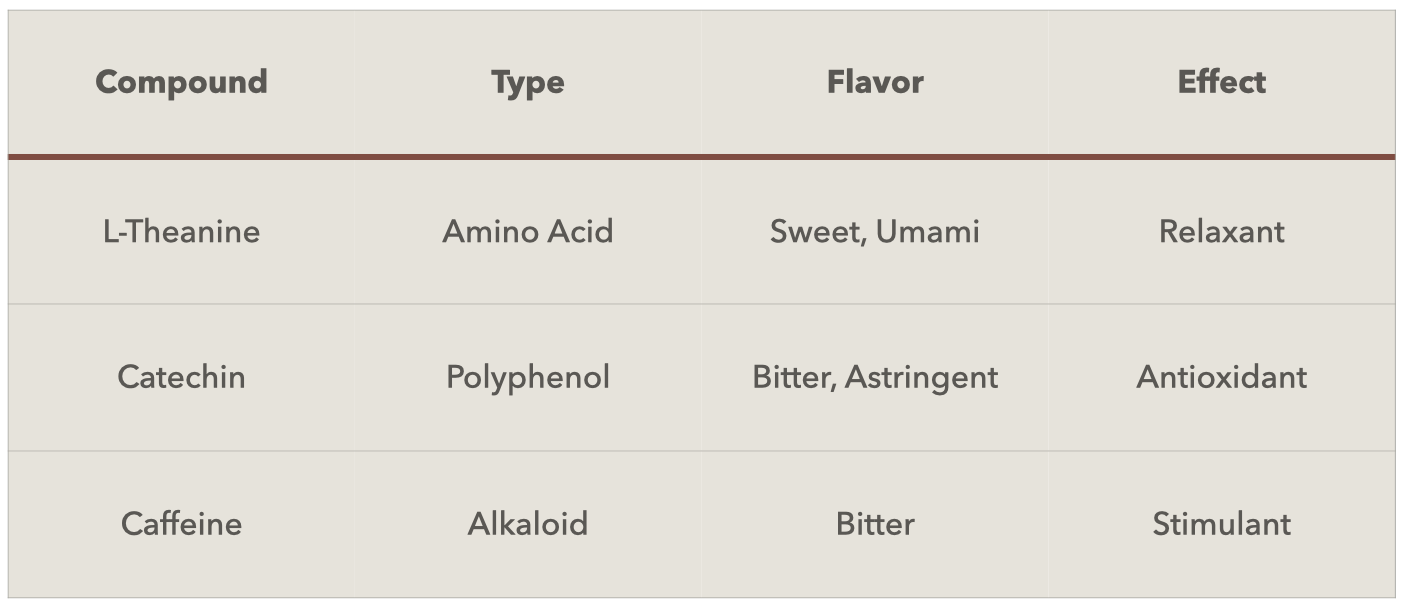
L-Theanine is the compound most unique to tea - of all the plants in the world, it’s the only one that produces it. L-Theanine is an amino acid that tastes umami and sweet, but most importantly it acts as a relaxant. Catechins on the other hand, are polyphenols and taste bitter and astringent, but act as antioxidants. And we all know caffeine, it tastes bitter and acts as a stimulant. Combining L-Theanine with caffeine leads tea drinkers into a “relaxed caffeine high” or prevents you from getting caffeine jitters.
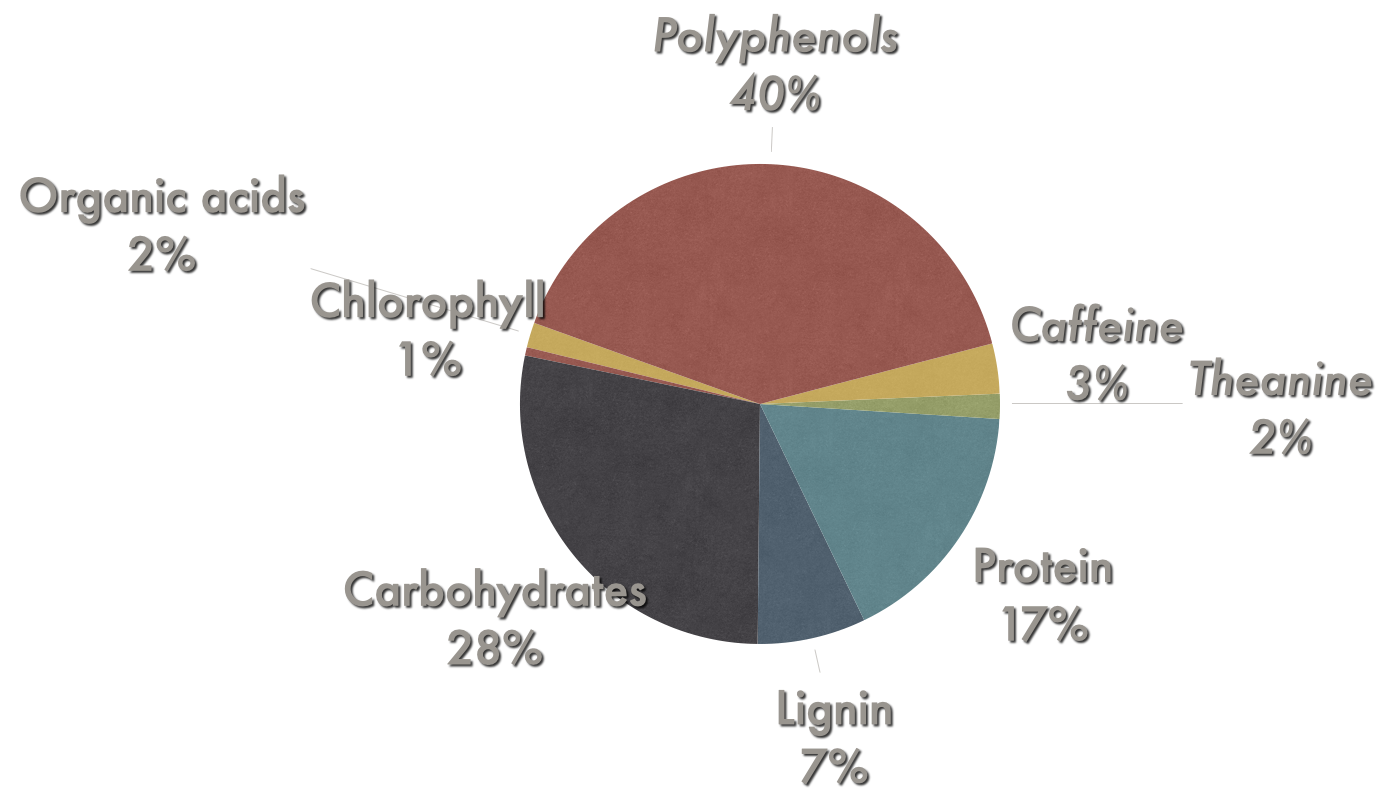
Tea Dry Weight Composition
If we talk about the dry weight of a freshly-picked tea leaf, we find that 30% is composed of catechins, whereas caffeine and L-theanine both are 2-3%. It seems as if catechins heavily dominate the tea leaf in terms of composition, but we’ll talk about how oxidation transforms these catechins into different compounds and produce the different types of tea.
Oxidation in Tea
When we cut an apple, the apple starts to turn brown over time, due to a process called oxidation. When we pick a tea leaf, an equivalent chemical reaction happens, and the tea leaf starts to brown. We refer to oxidation typically for catechin oxidation, which is the process in which catechins combine with each other to form larger polyphenols. Polyphenol oxidase will catalyze the reaction of two catechins to form theaflavin, shown in the image above. [1]. Then, using a similar oxidation process, the theaflavins combine to form thearubigans, and then in turn into theabromines.

Catechins combine to form Larger Polyphenols with Polyphenol Oxidase
Through this processes, oxidation transforms catechins to be different compounds which are less bitter. This means that bitterness and astringency get reduced as you oxidize the tea. It also tends to transform the color of the tea as well, with more oxidation, the darker the tea (probably due to larger molecules absorbing more light). We can already see that the tea types correlate with the tea color, with green tea being the least oxidized (green is due to the prescence of chorolophyll being unoxidized as well), yellow and white tea having a golden shade since it’s mostly composed of theaflavins, black tea being a reddish color due to thearubigans, and dark tea (like Pu-erh) being brown due to theabromines. Did you know chocolate are composed of alot of theabromines (color is the same!)?
How do we get different levels in oxidation in tea processing? We want to two compounds to come together to react, since oxidation is a chemical reaction. The substrate and the enzyme are held back from each other by cell walls while it’s living, since plants mediate these chemical reactions to stay healthy. But, as we pick a tea leaf, the cells inside start to die and break down, destroying the barriers that separate the catechins from the polyphenol oxidase. Therefore, one method of oxidation is waiting for the chemical reaction to happen. This is called withering, where you set the tea leaf out in the sun and hope that the substrate and enzyme come together. You can imagine that this is quite slow, compared to another option, which is physically bring the reactants together. This can be done by rolling the tea leaf to aid in cell breakdown, which allows much of the catechins to be oxidized. In between the two methods, we have what’s called bruising, which is a mix between the two. Instead of violently breaking down cell walls by rolling, instead we let the leaves hit each other, which causes minute cell damage, and let it rest for an hour in between shaking, in order to let the oxidation occur at a slower rate. This allows you to oxidize in the large range between 20-80%, which suspicously sounds like the range of oxidation for oolong teas (hint: this is exactly the oxidation process used!).
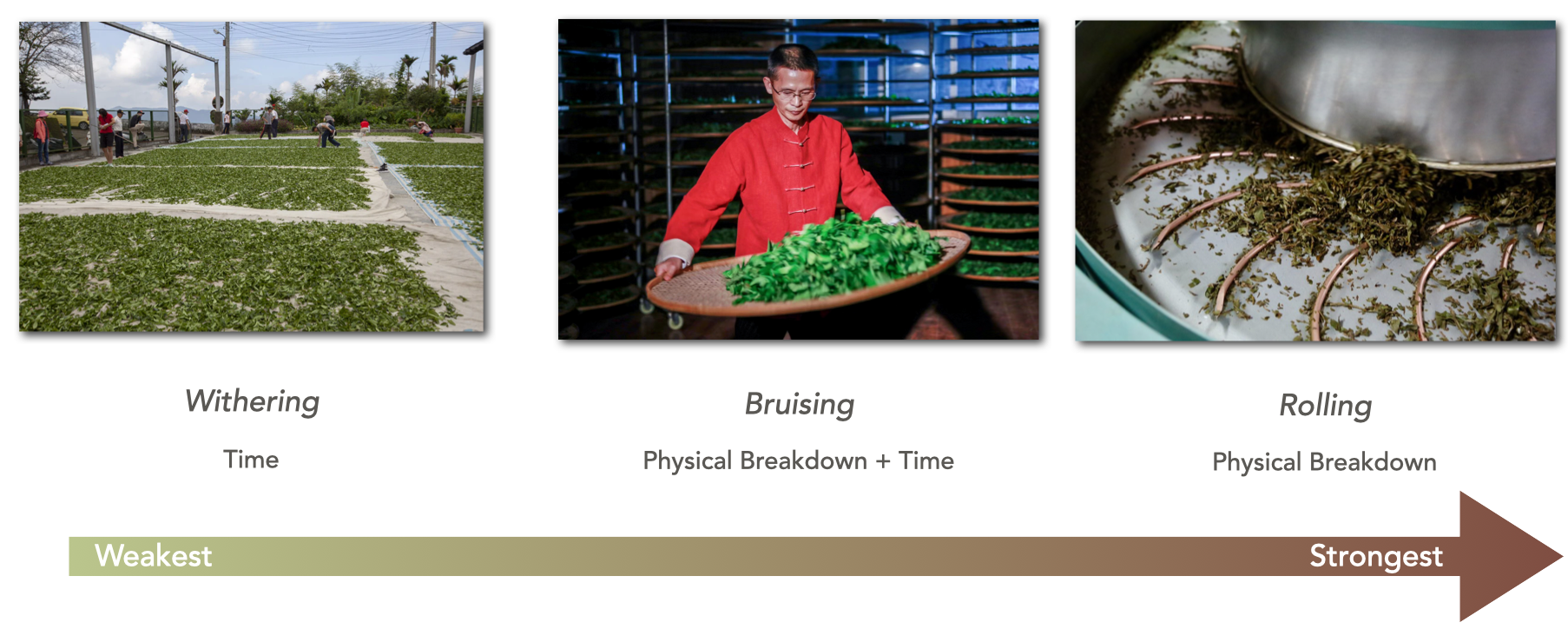
Tea Processing Oxidation Methods
Having covered how to create oxidation, once a tea master gets a desired level of oxidation from the tea leaf, which they have acquired years of sensory experience touching and smelling the leaf, they can decide if they want to stop oxidation. Now how do we stop a chemical reaction from happening? Easy, get rid of the catalyst! Enzymes denature at high heats, and the process of killing these enzymes is called fixing. Typically, it is done by steaming in Japan, and done by pan-firing in China.
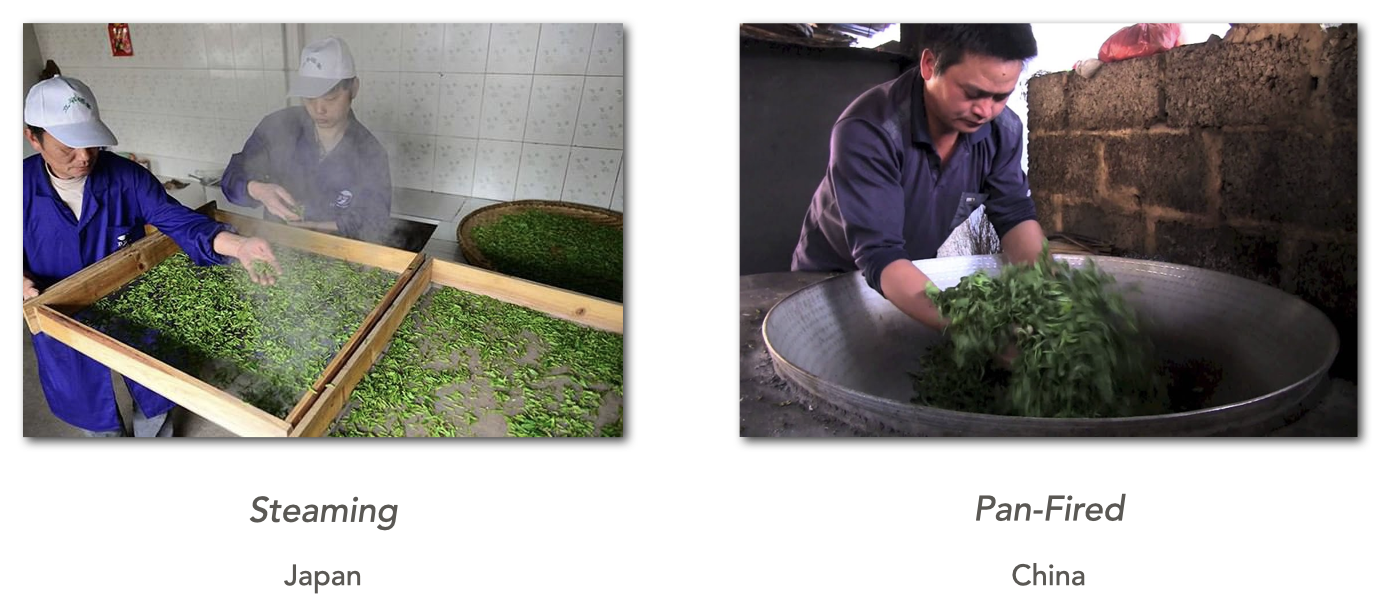
Tea Fixing Methods
Steaming which is more popular in Japan tends to result in a more grassy and floral aroma, whereas pan-firing, more common in China, typically gives a more chesnut aroma. Though there are some Japanese teas called kame-iri cha that are heated on a hot surface but it’s very rare.
Tea Processing Through the Lens of Oxidation
Putting together all of our new knowledge on oxidation, we can now attempt to classify the different ways of oxidizing to the tea types.

Tea Processing: Green tea is actually most similar to dark tea in processing,
even if they look and taste wildly different
Fixed Teas
Starting from the top, if you choose to fix the tea after you make it, you have the choice of applying alot of high heat to get rid of all of the enzymes, which after you dry will give you green tea. This allows for green tea’s grassy taste, since very little of the compounds have oxidized. Green tea color can vary based on green tea specific methods, but the green color comes from unoxidized chlorophyll.
However, if we fix only enough, to leave about 5% of the catechins left, then there are a couple of ways that the catechins can be transformed. First, if you make yellow tea, you can keep it in a warm humid condition where the leaves are piled up on top of each other. These allow for oxidation to happen from the air, albeit much slower. It also allows microbial communities to form which will break down the catechins and carbohydrates. Therefore, the oxidation you get from this method depends on the amount of time you spend in that stage. The tea will result in a rolled tea leaf that produces a yellow liquor.
Dark tea is yellow tea on steroids. Instead of just letting it rest for 6 hours, people let it sit for two days, which has alot more oxidation. The goal here is to transform all the catechins into other compounds, to reduce astringency and increase sweetness. If all the catechins are converted during this processing stage, it creates what’s known as ripe dark tea, since all of the catechins to transform into theobromines and it’s ready to drink after processing. Or, you could convert all of it during storage time, where microbial communities transform catechins in the tea into other compounds over a long storage time, which is why raw tea is aged. Tea liquor will be very dark, heavy with theobromines.
Withered Teas
The purpose of withering is not only for oxidation (remember, time oxidizes picked tea), but for continuing other metabolic processes involved in aroma formation. A couple of stressors are at play here: drought stress, heat stress, and pH stress which is all involved in aroma formation. But there’s also a couple of enzyme mediated processes as well, certain enzymes are able to break apart molecules made up of aromas and sugars, so there are free sugars and aroma molecules available after breaking apart. Other enzymes include protease enzymes, which break down proteins into amino acids, which are very sweet and umami, and cellulase enzymes which chop down carbohydrates into sugars.
Now, if we wither instead of fixing it immediately, the wither time differs between tea types. For white tea, the tea is withered for quite a long time, about two days, but this doesn’t make the tea oxidize very quickly because time is not as effective as physical breakdown. It’s dried immediately after withering, so the final product is typically a leaf that’s not rolled, and produces a white-yellowish liquor.
For oolong and black teas, they’re only withered for about 5 hours before doing more oxidation work. For black teas, it’s the most simple. They are rolled for a long time in order to break down the cell walls and get all the enzymes mentioned above working. Then after they’re rolled, they are they are dried, and produce a tea liquor that is red. In chinese, black teas are actually called red teas, which is actually a more suitable name to describe its liquor color.
Oolong teas are the most production time intensive. Tea masters have to bruise the tea leaves in intervals of an hour in order to get it to the oxidation percentage they want. This is long work, as they have to repeat this process multiple times. Some tea masters even apply cold wind to the tea leaf, which creates particular aroma compounds in the tea as well due to cold stress. Then, once the tea leaf reaches ideal oxidation, they fix the tea leaf by applying high heat, and then roll the leaves into shape and dry it. This results in the largest range of tea colors, from whitish for the least oxidized kinds, gold for the mid-oxidized, and almost reddish for the very oxidized ones.
And those are the six tea types! All of the tea processing methods manipulate the ratios of catechins to L-theanine, allowing for different tasting brews, and create aroma compounds in different ways. Oxidation level is also one of the strongest signals to explain tea color.
What about L-Theanine?
When we think about flavor in the context of the compounds and their tastes, the sweet and umami flavors depend on the amount of L-theanine, sugars, and amino acids present in the tea leaf. Typically, the most important thing for L-theanine content is the amount of nitrogen present in the soil where it was grown. L-theanine is made from nitrogen compounds, which the tea draws from the soil while it’s growing. Therefore, the flush is incredibly important for getting the most amount of L-theanine in the tea, because first flush tea has the time from the last picking in the fall to the first picking in the spring to synthesize L-theanine. In the plot before, there’s quite a falloff on the amount of Theanine in the tea leaf after the first picking of the year (even within the same season)[2]. It’s also colder in the winder, which causes the tea to grow more slowly, which results in a more concentrated tea leaf.
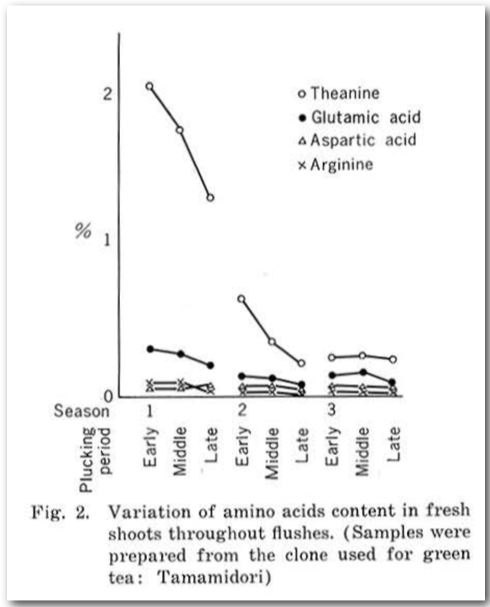
Tea Brewing
You may have wondered things like why green tea has to be steeped at such a low temperature, or why black tea can be steeped at a higher temperature. When we brew tea, we ideally want to optimize for balanced flavor. We can aim for a really balanced brew, one that’s umami forward, but we really want to avoid a tea that is really astringent and bitter.
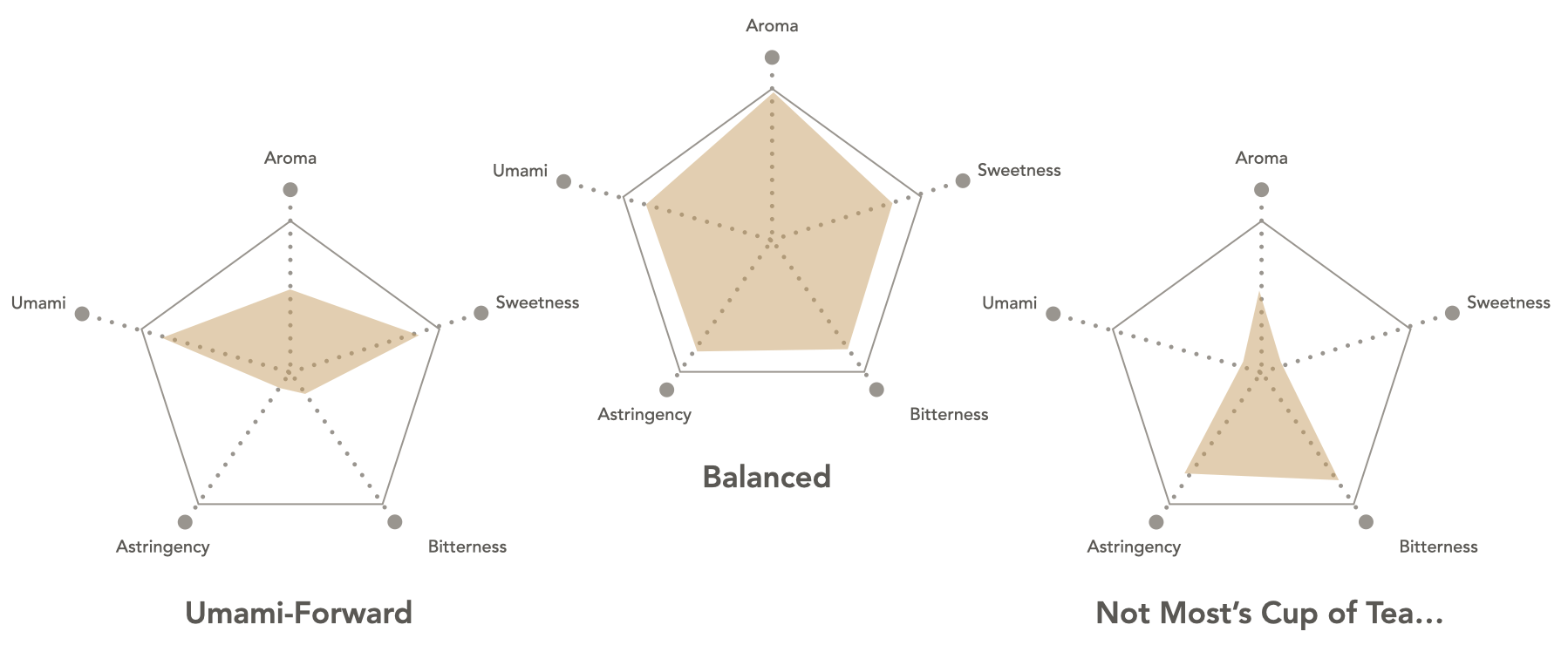
Aim for teas that have a balanced flavor profile. We'd like to avoid the one on the right.
Extraction of Tea Compounds into Water
Tea is a solution, where the soluble is the tea leaf dissolving into water. The compounds in tea extract at different temperature, and depending on the the content, might extract more quickly or slowly. Below in the table, we have sweet and umami L-theanine extracting best at 80°C, and it will extract completely after around 4 minutes. However, the more astringent and bitter compounds catechins and caffeine extract best at 100°C, and releasing completely into the water in 15 minutes and 4 minutes respectively. This means as you leave the tea in the water, the catechins continue to extract into the water, making your tea turn really bitter. So, it’s important to remove the tea bag after finish brewing your tea!
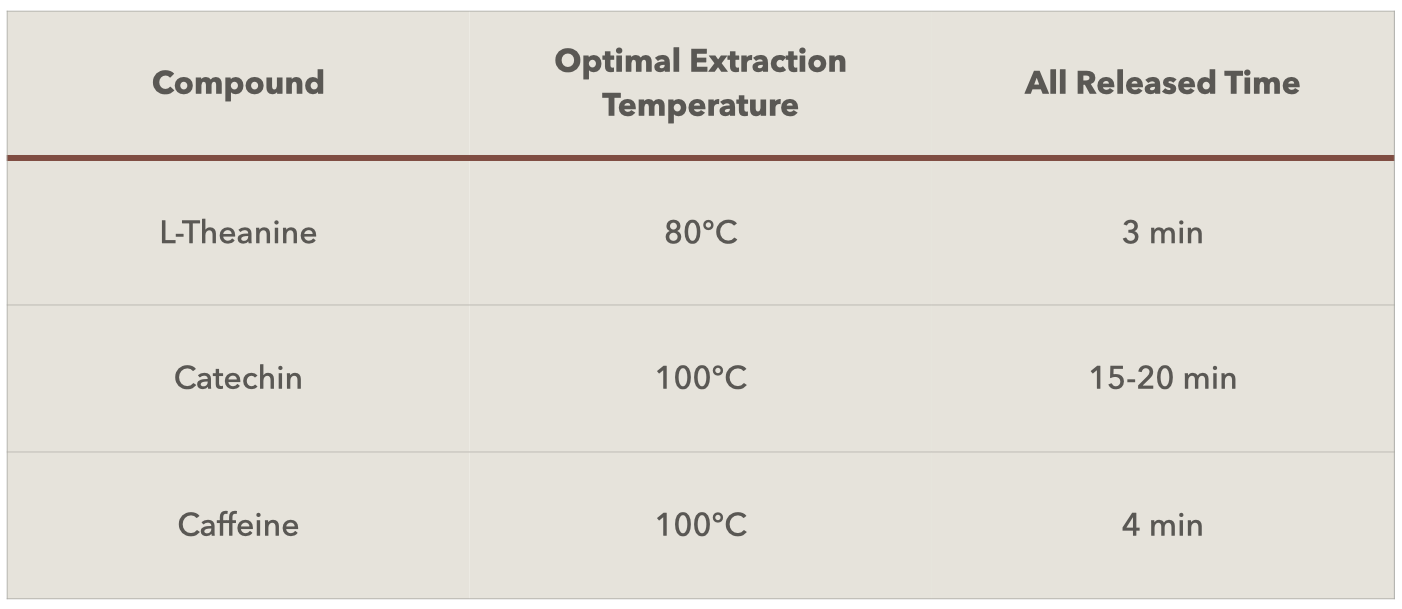
Extraction of tea solubes into water
You can probably already start coming up with a strategy on how to brew your tea based on the extraction temperature and time. For brews that have a large amount of catechins, as we learned that would be teas that are not oxidized or consumed by microbial activity, you want to brew at a cooler temperature to prevent the catechins from extracting too much. For highly oxidized teas, like black and dark tea, you can brew at a really high temperature without worrying about getting an overly bitter brew. So by the color of the tea, you can tell what kind of temperature you’ll have to brew at, since teas with less catechins have more thearubigins and theabromines.

Recommended Brew Temperature based on Estimate of Catechin Content
This all boils down to the ratio between catechins with L-theanine, but more generally (in the tea science literature) it is called tea polyphenol to amino acid content ratio (TP/AA ratio). In order to avoid having a large TP/AA ratio, you’ll want to brew at the recommended brew temperate, and reduce infusion time if you want to continue to have well-balanced brews. For particularly bitter prone teas, it’s probably best to cold brew to avoid extracting too many catechins. Many green teas taste wonderful cold brewed since they have alot of catechins and are prone to bad brewing. I recommend investing in a temperature control kettle for this reason, but you could also learn to use traditional ceramics like the yuzamashi to help you cool down your tea.
Asides
Now you’re probably well equipped to understand why the tea brewing advice is the way it is, and what the differences between the teas really are. It’s quite amazing that so much taste variety come from the same tea leaf, and can really get transformed through processing. Hope you have fun on your tea journey, but there are a couple of miscellaneous topics that I’ve decided to write about below if you’re interested in caffeine and other misconceptions.
Caffeine Content
Tea all comes from the same plant, where caffeine makes 4% of dry leaf weight. So why do people think that black tea has more caffeine than other tea types? It mostly comes down to the quality of the tea leaf processing and brewing instructions. Bad quality tea consists of harshly cutup leaves, which basically release all of their compounds into the water very quickly since they’re not rolled, therefore all caffeine gets extracted into the water. Most of the tea produced (hence, drank) in the world is actually bad quality black tea (think Lipton tea). Higher quality teas also tend to have higher L-theanine content since it’s the first picking of the season, and if L-theanine and caffeine are taken together, people feel don’t feel the jittery effects of caffeine due to the relaxing properties of L-theanine.
Additionally, if on average most people brew an equivalent quality green tea at a lower temperature than black tea, then it’s likely that the black tea will extract more cafffeine for an equivalent amount of brew time, leading people to believe that black tea is more caffeinated than green tea. Therefore, it’s not that the tea leaf itself is more or less caffeinated, it’s just that the brewing style and the quality of tea really play into people’s perception of feeling caffeine. If you were to brew all of the tea types at 100°C for 10 minutes or something, they’d all likely have the same caffeiene extraction since you won’t be confusing the other processing factors.
Processing does very little to change the amount of caffeine that’s in the dried tea leaf itself, however tea growing practices themselves can affect the amount of caffeine, becaues it’s directly influences the amount of compounds being synthesized [3]. For example, gyokuro, which has been shaded more most of its lifetime, creates more caffeine and chlorophyll as a stress response to having less access to sunlight [4]. Varietal can affect the caffeine content as well, since Assam tea has slightly more caffeine than the Sinesis varietal as well [5]. However, if you were to measure people’s everyday brew, it’s likely that the amount of caffeine in every cup is highly varying based on the temperature and extraction time, and hard to generalize tea types to have certain amounts of caffeine.
White Tea is not the Least Oxidized Tea
Many people tout that white tea has the least amount of caffeine, which is wrong given the discussion in the previous section on caffeine. However, other arguments like it’s the least oxidized tea are irrevocably wrong. It is arguably the “least processed tea” perhaps if you’re counting the number of steps that it takes to complete the tea processing. But in terms of the complex aroma formation that occurs during the withering processing, white tea is definitely not a simple tea. By oxidation, green tea is definitely less oxidized than white tea.
References
[0] Dylan’s Wonderful Masterclass on Tea: https://youtube.com/playlist?list=PLeK5s_4Pb8528z06MYcc_XMfd5V7ZJmUv
[1] https://www.ncbi.nlm.nih.gov/pmc/articles/PMC8840101/pdf/molecules-27-00942.pdf
[2] https://www.jircas.go.jp/sites/default/files/publication/jarq/05-3-043-047_0.pdf
[3] https://www.adagio.com/info/caffeine_and_tea.html
[4] https://nioteas.com/blogs/tea-facts/chemical-composition-of-green-tea
[5] https://pubmed.ncbi.nlm.nih.gov/11714326/